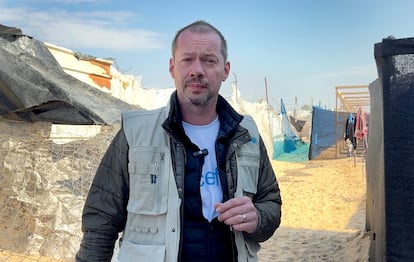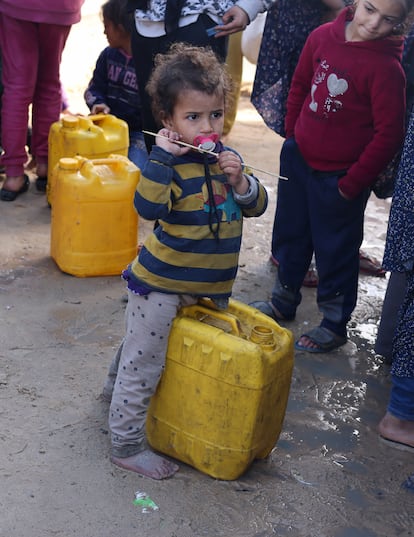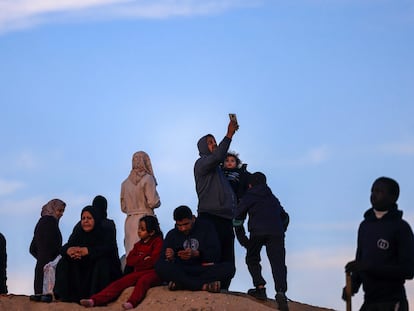UNICEF official in Palestine: ‘There are one million children in Gaza traumatized by the war’
After the outbreak of the conflict, the U.N. agency maintains that practically all children in the Strip are in a situation of maximum vulnerability


From Rafah, at the southern end of the Gaza Strip on the border with Egypt, Jonathan Crickx describes a sea of improvised tents, where 1.3 million Palestinians are crowded amid the sound of Israeli bombings coming from the city of Khan Younis, around three miles to the north. In a conversation interrupted by continuous phone line outages, the head of rights advocacy and communications for UNICEF in Palestine notes that the population has quintupled in the south of the coastal enclave due to the massive displacement forced by the war. “Every day more and more arrive here, where they can barely be offered a little food and some water to survive, between 1.5 and two liters per head per day for drinking, cooking, and washing,” warns the Belgium-born humanitarian worker, who cut his teeth in the Middle East and Afghanistan.
Some of his U.N. colleagues in Gaza have lost family members. Dozens of them have even been killed. “Since the beginning of the war, more than 150 employees of UNRWA (the U.N. agency for Palestinian refugees) have perished in Israeli attacks,” he says. With 13,000 employees in the Strip, UNRWA is the main organization providing aid to the civilian population. Two million of the enclave’s 2.3 million inhabitants depend on this agency to survive. The United Nations has dismissed several UNRWA employees after they were accused by Israel of being involved in the October 7 attacks launched by Hamas, in which some 1,200 people were killed on Israeli territory.
UNRWA has already warned that it will not be able to continue its operations in Gaza beyond February if the 16 countries that have withdrawn their economic support, including the U.S., the United Kingdom and Germany, do not resume their contributions. The usual hardships faced by the agency may be exacerbated by a lack of funding. The humanitarian situation in the Strip threatens to worsen if UNRWA loses more than half of its income.
“Hygienic conditions in Rafah are terrible: there is only one latrine for every 500 to 700 people, leading to the spread of diseases such as chronic diarrhea,” Crickx says. “In the few weeks since the end of December, cases have risen from 40,000 to 70,000; and it is one of the leading causes of infant mortality. The impact of the war on children’s health is very worrying.”
In Rafah, where he observes numerous buildings destroyed by Israeli shelling, Crickx reports that no direct attacks are being recorded now. “The war has already caused more than 26,000 deaths, 70% of whom are women and children,” he says, citing data from the Gazan Ministry of Health. “But the situation is very complex and we can only make estimates, without being able to differentiate by type of casualties.” He considers that in view of the internal exodus of the population and with most of the hospitals destroyed or on the verge of collapse, “counting the deaths of children is a challenge.”
In health centers that are still partially functioning, he notes that the occupancy rate exceeds up to 300% of the patient care capacity. “In one recent case, a woman who had given birth by cesarean section was discharged a few hours later [in order to free up a bed],” he details. “She didn’t even know how to clean her wound.” She acknowledged as much to the UNICEF staff who treated her in southern Gaza. “There are many minors hospitalized in corridors for lack of other space, with hardly any assistance or medicine,” warns Crickx. The World Health Organization (WHO) has detailed a dramatic situation in the hospitals, with an almost total lack of anesthesia and painkillers, and of basic medicines.
From the tent city that has sprung up in recent weeks, Crickx acknowledges that the war threatens to move closer to the Egyptian border. “No one knows when it will get here, so we are hoping for a ceasefire as soon as possible,” he says. Before the war, some 400,000 children were in need of mental health treatment and psychological support in Gaza. After the outbreak of the conflict, UNICEF maintains that practically all children in the Strip (40% of its 2.3 million inhabitants are under 15 years of age) are in a situation of maximum vulnerability.

“I felt helpless”
“There are one million children in Gaza traumatized by the war and waiting for a ceasefire. We don’t have access to all the children, but in view of the duration and intensity of the fighting, we estimate that all of them are in need of mental health and psychological care now,” Crickx adds.
The aid worker reports from Rafah that almost all the children he has met have told him they have lost a family member in the fighting. He cites the case of Hasane, an 11-year-old girl. “It really struck me. She lost her father, mother, brother, and two sisters, and she also lost a leg in the war,” he recalls. “It was hard for me to listen to the story of a little girl bathed in tears scarred by so much grief. I felt helpless.”
“But many people, many children, were also killed on October 7, in an absolutely horrific attack in Israel,” Crickx adds. “What is really needed in Gaza, in addition to urgent humanitarian aid, is a prolonged and lasting ceasefire. The grief felt here is very intense. For the sake of all the children, the fighting must stop.”
“The aid that is coming in is insufficient”
“As you can see for yourself, we have a lot of difficulties in maintaining communications and coordinating our work. For example, to try to get medical supplies to a hospital,” he explained between line cuts last Saturday. “The aid that is coming into Gaza is insufficient. For security reasons, it is also not possible to reach everyone who needs help and all areas of the Strip,” Crickx acknowledges. “UNICEF is delivering highly nutritious baby food for 40,000 children under five, an age range that accounts for 330,000 children in the Strip. We cannot meet all the needs,” laments the representative of the U.N. children’s agency.
Sign up for our weekly newsletter to get more English-language news coverage from EL PAÍS USA Edition
Tu suscripción se está usando en otro dispositivo
¿Quieres añadir otro usuario a tu suscripción?
Si continúas leyendo en este dispositivo, no se podrá leer en el otro.
FlechaTu suscripción se está usando en otro dispositivo y solo puedes acceder a EL PAÍS desde un dispositivo a la vez.
Si quieres compartir tu cuenta, cambia tu suscripción a la modalidad Premium, así podrás añadir otro usuario. Cada uno accederá con su propia cuenta de email, lo que os permitirá personalizar vuestra experiencia en EL PAÍS.
¿Tienes una suscripción de empresa? Accede aquí para contratar más cuentas.
En el caso de no saber quién está usando tu cuenta, te recomendamos cambiar tu contraseña aquí.
Si decides continuar compartiendo tu cuenta, este mensaje se mostrará en tu dispositivo y en el de la otra persona que está usando tu cuenta de forma indefinida, afectando a tu experiencia de lectura. Puedes consultar aquí los términos y condiciones de la suscripción digital.
More information
Archived In
Últimas noticias
Most viewed
- Sinaloa Cartel war is taking its toll on Los Chapitos
- Oona Chaplin: ‘I told James Cameron that I was living in a treehouse and starting a permaculture project with a friend’
- Reinhard Genzel, Nobel laureate in physics: ‘One-minute videos will never give you the truth’
- Why the price of coffee has skyrocketed: from Brazilian plantations to specialty coffee houses
- Silver prices are going crazy: This is what’s fueling the rally










































